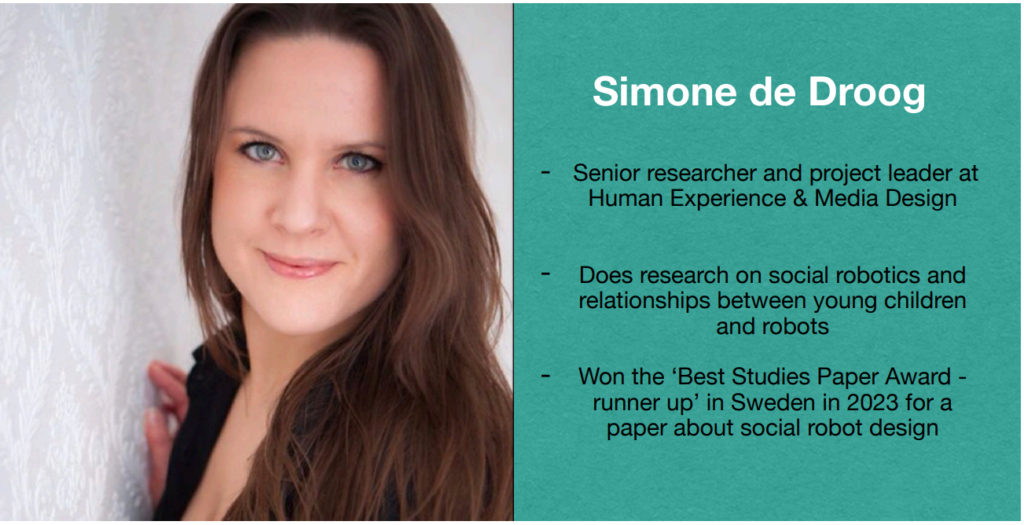
What’s your interest in robots?
I am particularly interested in the relationship between robots and children. It’s not so much the technology itself that I find interesting. I find anything non-human that we interact with to have something magical about it. In the past, I have not only looked at robots, but also at characters and animations. It’s fascinating to see that something non-living can have such an impact on a child; that they can experience so much joy from it and feel so much affection for it. And because of this, you can use robots, for example, to encourage children to exhibit certain behaviors and adopt certain attitudes that they might not otherwise have so easily. So, the interesting part lies
mainly in using robots in a positive way for children.
When is something considered a social robot?
A social robot is used to interact with a human. In practice, you often see two different types of social robots: those in human form and those in animal form. Social robots can be used for comforting, entertainment, distraction, or for affection (especially the ones in animal form). The human form is also often used for conversations, to teach you something, or to guide and improve social interactions. These types of social robots differ from the purely technical robots
that are used in industry and hospitals, and that take over certain tasks from us to make work more efficient.
You recently completed a study on the formation of relationships between robots and young children. Can you tell us more about that?
Last year, we mainly looked at what we already know about the formation of relationships between robots and children. We looked at the academic research and spoke to professionals, which led to an opportunity map that shows the factors that may drive interactions and relationships between children and robots.
In another study we looked at children’s relationship formation with a math robot. What I thought was an amusing result from that study is that children can, on the one hand, regard robots as a friend, while at the same time understanding that they are not real. They answer ‘yes’ to the question whether the robot is their friend and indicate that they would like to get to know the robot better, for example by hearing it talk about its interests and hobbies. But when asked whether the robot can see them or has feelings, you often see the child hesitate. The interesting thing is that for the formation of friendships, it doesn’t matter that the robot is not a living
breathing creature.
What are you currently working on?
I am currently focused on grant applications for new projects related to robots. An example of this is a project involving a ‘dream robot’, where we aim to reduce fear and pain in children in healthcare through the use of a robot. This may be achieved by programming the robot to apply guided imagery. This medical hypnosis technique uses positive suggestions to bring children into a fantasy world, shifting their focus more towards their imagination than the pain.
I am also working on a follow-up to the SOROCOVA project that I completed last year. In that project, we worked in primary schools with a math robot that could adapt the material to the student’s level, provide help and personalize the interaction and lessons. For this project, my collaborators and I also won a ‘Best Studies Paper – runner up’ award at the Human-Robot Interaction (HRI) conference in Sweden last year.
In continuing that project, I want to focus more on addressing negative emotions in children that can arise during a math task, and how a robot can help with that. For example, if children experience anxiety or a loss of confidence, the robot takes this into account and coaches them to overcome this.
How is your research applied in practice?
I mainly conduct practical research together with the potential users of robots. My previous research with the math robot was developed in collaboration with the education sector and was actually used in the classroom. For the dream robot project, we will work with hospital staff to develop a plug & play robot that can be implemented as an aid in different hospital environments.
Nevertheless, implementation remains a difficult obstacle and many robot solutions are still in the prototype stage.
My theoretical research on relationship formation is primarily intended to encourage society, or at least those working with robots, to further explore how we can stimulate and support relationship formation with robots. We also aimed to inspire researchers to learn more about relationship formation with robots, as there are still many unanswered questions.
Finally, what are your goals for this year in terms of research on social robots?
I mainly hope that by using the dream robot, we can reduce pain and anxiety among children in hospitals. If the funding for this project is secured, it means that we will collaborate with five hospitals and can truly make an impact. That would already make this year a success for me!
Read Simones article on math robots in education.
